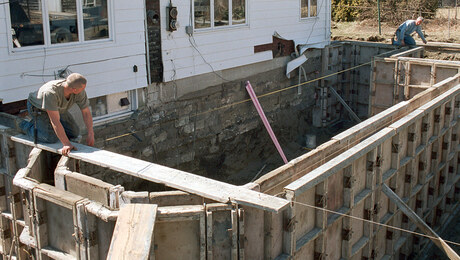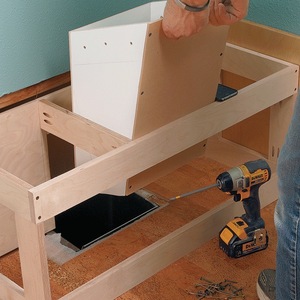Recently purchased acreage in Southern Ohio and am designing a small cabin/retirement home that I will soon (this winter) build for myself out of mostly rough cut oak/ t&g pine. (no 4×8 sheets of anything) The roof will have oak rafters covered by t&g pine (that will be seen from the interior of the house). My expertise ends there.
I want to apply foamboard onto the exterior side of the T&g for insulation and cover that with metal roofing. Does anyone know the best way to do this? I’d rather not have to buy the ply/foam/ply sandwiched stuff. OSB is so terribly overpriced, I’m thinking of firring strips for the metal roofing….


















Replies
What I've done before is laid a vapor barrier over the t&g and then run another set of rafters on top of that. The thickness of your insulation will determine the rafter size. Then put on your sheathing,paper and metal.
Good luck, Dave
Thanks Dave...will do.There are fast carpenters who care..... there are slow carpenters who care more.....there are half fast carpenters who could care less......
Jim,
Got curious as to how many inches of foam board you plan on using for you roof?
And to all, was wondering if taped seams on foilback half inch celotex foamboard insulation laid on the topside of the t&g pine, thereby under the bulk thickness of the rest of the foam board insulation, would be sufficient as a vapor barrier?
And would multiple foamboard thicknesses, say 2 layers of 3 inch foamboard, need to be bonded together to prevent a moisture pocket forming between the foamboard sheets?
Here's how I've done it. Only works out to about R20 counting R5.2 dow blue and R=1/inch for 1-1/2" decking t&g. I put tarpaper for VB, spray foam joints in the foam and stagger end joints..
Excellence is its own reward!
Got curious as to how many inches of foam board you plan on using for you roof?
Not sure. cause I don't know the r value of the foam, (I need to check) but I'd like to get by running 2x6 like this and filling tightly with foam. So it would be 3/4 T&G covered with 15# felt... then the 2x6 (or 8)...fill the spaces with foam...firring strips (or ply) then the metal what do you think? ...........Would I even need to ad firring or could I apply the metal directly to the 2x6 (or 8)? I'm not thinking you'd need an air channel. Would you?
There are fast carpenters who care..... there are slow carpenters who care more.....there are half fast carpenters who could care less......
Edited 9/27/2003 7:56:01 AM ET by JJWALTERS
I personaly like the blue Dow foamboard over any kind of fiberglass batts. Not just because of fiberglass losing it's jazz if it ever gets wet, or the fact of spun fiberglass being what it is, but I question the validity of the documented tests done for r-values and the necessity of exact placement techniques to get those values.
Foam board leaves little to chance by comparison. And when picking a sheet up by your fingers, 5 seconds later you can feel the heat reflected back from your hand.
I think Piffin's pic showing coverage over the total instead of just between and then firring gives the best bang to keep the heat in since you're covering the 2x6s and it'll prove alot easier to get a tight job out of it.
I'm inclined to always vent. But I'm a rookie. Hey, I even go for rain vents under the siding.
See if you get lucky and the search button works. Vent wars from last year I believe.
JJ,
Since cost is always a factor for us, you may wind up finding it cheaper to use fiberglass than dow blue which is still very expensive. EPS board (expanded polystyrene, the white "bead board"),is cheaper, but far inferior from most standpoints.
I have had two bad experiences, one ongoing, with styrofoam. The worst is on my own house. Dow blue seems to be the favored building material for colonies of carpenter ants. They spend all winter nice and cosy in the insulation, and come out in the spring with voracious appetites. 30 years worth of spraying has made no significant difference from what I can see. The foam makes it much harder to get poison to them than would fiberglass. I would never use foam in the woods of Maine again for this reason.
Termites also greatly favor foam. I had an old pair of obsolete Head skiis, which were great for waist deep powder in the rockies, that I set outside on the ground in the Fla Keys for three days. When I remembered to pick them up, they were completely delaminated, and hordes of termites came out from the inside carrying eggs with them. Not from just one, but from both skiis. They had almost completely removed the foam core.
Anyone else have these types of experiences? Could just be that wood destroying insects chase me like lightning chases some people.
I thought I'd mention this in case you are in a deep woods setting.
Good luck.
Clampman
Egads man, now you got me sweating bullets!
interesting cause I'm in heavy woods. Have to check the bug thing out.......didn't realize the little ******* ate foam.There are fast carpenters who care..... there are slow carpenters who care more.....there are half fast carpenters who could care less......
They don't eat the foam. They don't eat wood either, they just tunnel into it for a home. Unfortunately, along the way, they dragin some bacteria and mold spores that can do other damage if moisture is present. The ants also don't like the wood or the foam if it is too dry. They need moisture too. Most ant damage is at ground level. We see very little when there is eighteen inches between the ground and the siding.
Foam on foundations can beome an ant colony. Ants in foam or wood on the roof level is rare and incidental. If worried, borate treatment is an option.
Dow Blue is 5.2/inch, I think, and the Thermax foil faced is around R7/inch. There is also foam as low as r3.5/inch.
Excellence is its own reward!
Piffin,
You are absolutely right. Ants don't eat either wood or foam. I wish they did. Instead they just chew it up and spit it out all over my living room floor. They also like to chew on at least one oak stereo cabinet as well - mine. And I don't keep it in either the kitchen or the bathroom or the basement either.
I know they need water. Everything needs water - except me- I need coffee. But the little buggers don't need much, how much can there be in my stereo cabinet top? The colonies that are living in my styrofoam insulation on the roof are probably chewing through the roof sheathing to get to the tasty green moss growing on the asphalt shingles.
The ones I have may be smarter than the ones in your neighborhood. I never see any down near or under ground level in the basement. They like to spend their winters up in the roof where it is nice and warm.
I may wind up having an excavator bury the place in boric acid for a year or two. Dumping it around the walls for 30 years has had no more effect than having the exterminators crawling around the roof every other year with their indian pumps. Maybe they are just spraying water in the bays for job security; that's probably it.
It's just my luck that I got another rare case of something. Psychotic ants that live in the roof and sneak down at night to chew holes in my stereo cabinet. And two thousand miles away, tropical termites that like my snow skiis for crying out loud.
Well, at least they leave my coffee alone. I got to go now. Am researching sources in Africa for some pygmie anteaters.
Good luck to you all.
Clampman
Edited 9/28/2003 1:35:05 AM ET by clampman
Obviously, you brew too much coffee and the steam from it rises to permeate the roof structure, the condensate providing their necessary moisture quotient.
They get just enough caffine from that supply to envigorate them and expand their ambitions. In their nightly excursions, They discover that you spill coffee regularly on the oaken wod entertainment center so they flock to it in search of getting off on better drugs than they are userd to. When the caffine supply dries up, they get off on the music you choose for them.
They are probably closly related to the lobstants that were featured in the piffin and marion chronicals here at BT. Now that you know you have a lobstant farm (exotics are the in thing for breeders) you simply need to develope a market for them. mint flavored, chocolate covered lobstants sounds good - you'll just have include caffine, borates, and miscellaneous other chemicals on the ingredients listed on the wrapper..
Excellence is its own reward!
do you have lage trees overhanging the roof?.
Excellence is its own reward!
There is truth in what all of you are saying. You are right about the condensation. That was the first house I ever built, and I didn't have a clue what I was doing. How hard can it be to build a house, for crying out loud? The house being in the woods, is surrounded by trees of the worst type. Poplar - the blueberry pie a la mode of the tree eating world - beavers' choice. Unfortunately, only beavers equipped with crampons, pitons, and rapelling gear can get to them, so they keep growing at about 5' per year.
To compound the problem, the house was framed in part by old barn beams, probably already infested with ants. Since building that place, I've done a lot of others from the Keys to the Rockies to the Southwest to New England, to the Congo rain forest. From my point of view, the only way I will ever frame another catherdral ceiling is with a cold roof - one with enough free flow to allow a 10 year old to go spielunking in the bays. And the ridge would, as on previous projects, have a framed ridge vent. The manufactured ones do not allow near enough air flow for me. And the underlying roof would be insulated with fiberglass, not foam.
I think the foam causes too many condensation issues in a roof system. The only things that like to live in fiberglass insulation are big enough to pick off with my pellet gun. And I've never seen them living in a 9/12 pitch anyway. Plus, they don't grow wings and swarm every spring: if they did, I'd need to buy a little 20 Ga., then worry about the windows.
I once shot a bat with a .22 that was squeeking non stop and keeping me awake. Then I woke up freezing. The round had gone through the thermostat wire and shut off the furnace, after it got the bat. Just my luck.
Yeaaaaay fiberglass. Boooooo styrofoam.
Clampman
Rez,
I'll be inspecting my coffee more closely from now on.
I think what is needed from the foam manufacturers a new foam - - something like " polyisocyanidicarsenidicrutabega" Nothing would eat that-not even rug rats.
Clampman
Yah, I never cared much for rutabegas myself.
Old beams with built in colonies, eh?
Under massive poplars, eh?
No other vapor barrier? too
I KNEW THERE WERE EXTENUATING CIRCUMSTANCES.
;)
BTW, foam has fewer condensation issues than fibreglas unless you allow draft gaps when you install it. Use a VB and seal the edges together and you eliminate dewpoints to allow any condensation.
Critter story-
Several years ago, I was hirted to replace an Ondura roof on a house that had both 9/12 and 12/12 sections. The ondura was laid over furring @ 24" OC with 9" of fibreglass between the rafters. Either squirells or rats had made lots oif tunnels and nests in that FG, and had made desert out of the insulation on the wiriong running through it. I had to tarp and delay the job while the electrician de-sparked the place. My two surprises were that the place was not full of electrocuted mini-mammals and that it had not burnt to the ground..
Excellence is its own reward!
to the Congo rain forest
Now, that's interesting. There are fast carpenters who care..... there are slow carpenters who care more.....there are half fast carpenters who could care less......
Next time you get ready to brew up your java take a closer look at all those other brown specks you never saw before in the grinds.
Truly recycled foam. I wonder if it still carries an effecient R-value?
Consider putting SIPs over your T+G pine. I think that's an ideal application for SIPs - you'd get an unbroken layer of insulation, and the installation would be easy.
did
Blah, yada, whatever, Hi how are you today
SIPs?? What's that?There are fast carpenters who care..... there are slow carpenters who care more.....there are half fast carpenters who could care less......
Structural
Insulated
Panels
Sandwhich of foam with osb on both sides for post and beam style skinning or for full design erection .
Excellence is its own reward!
What piffin said. Although, since you'd have a nice structural deck to set these on (the "outer" surface of the T+G), you could save a bit of money and use nailbase panels, which are like an SIP but only have osb on the outer side. The foam side goes against your roof and you glue+screw through that into your rafters. This sounds like the perfect application for these things.
didBlah, yada, whatever, Hi how are you today
I addressed this type of installation in a recent thread here about a month ago. The material we used there for insulation was a polyisocyanure foam board 3" thick. Take a look at this job; there's quite a few photos. We also developed the interesting trick of shingling down the roof with the metal roof panels, which in this case were 8' long. Don't know if your roof will be short enough to cover with single sheets ridge to eaves. This one wasn't, as you'll see.
http://forums.taunton.com/tp-breaktime/messages?msg=34292.1
Dinosaur
'Y-a-tu de la justice dans ce maudit monde?
polyisocyanure foam board 3" thick.
Where'd you get it? How much? r-factor? That A-frame must have had the feel of workng on the face of a cliff. Did you get in some repelling practice?There are fast carpenters who care..... there are slow carpenters who care more.....there are half fast carpenters who could care less......
The stuff came from Atlas Roofing; the 3" model was a special order. I forget the exact R value, but it was higher than anything else we could find except sprayed foam, which was too expensive. A lot of the details as to why we did what are in that thread.
As for the A-frame feeling like a cliff face, that's exactly how I started referring to it after day one. But no, I didn't do any rapelling; if you read the whole thread, you'll come across a whole philosophical diabtibe about the use of safety gear and why and when and when and why NOT....
The thread kinda got hijacked. Sh!t happens.
I finally found my photos of the finished job (I knew I'd taken them; they were still in the camera on the beginning of a new roll, duh!)
The back wall showing in shot no. 2 is the one we ripped out and replaced last fall.
Dinosaur
'Y-a-tu de la justice dans ce maudit monde?